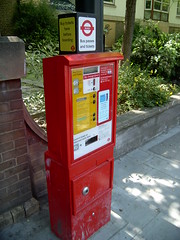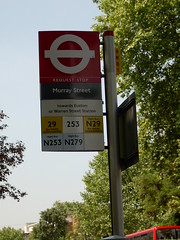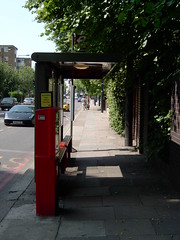on the buses
You all know the image. Red double-decker Routemaster buses making their way down the streets of London. An instantly recognizable symbol that many tour operators have latched onto around the world.
When I lived in London, I rarely used buses. My feet took me to most places I needed to go, while the Underground was there for longer hauls. I recall only on kamikaze bus trip, where I hopped on to see where I wound up (answer: St. John's Wood). My main memory of any UK bus occurred in Edinburgh on a trip in grade 10, where the maroon/purple double-decker I was on passed by an accidentally caused by someone driving on the wrong side of the road.
"Lousy Canadians", the driver muttered.
***
Before heading over, I purchased a Zone 1-2 Travelcard (22 pounds), which allowed unlimited use of the transit system anytime outside of morning rush. Most commuters use the Oyster smart card system. If you lack a pass or Oyster card, you must purchase a ticket before hopping on a bus. Many stops are equipped with ticket machines, such as the one below. Tickets are also available at select corner stores.

Oyster users touch their cards to sensor, much like Speedpass on Esso gas pumps. Other users flash their ticket in front of the driver (though I was bawled out once for producing it too quickly). I suspect it would be easy to hop on the rear without any sort of payment, since only Oyster scanners exist there. Drivers are barricaded in a Plexiglas booth, preventing contact with other humans.

This sign marked my usual stop on this trip, across the road from the residence. Note that it is a request stop, which means that you need to hail down a bus like a taxi. Arm goes up, bus stops. Simple. Useful for avoiding confusion if your stops serves multiple routes.

Each shelter comes with a map of local routes, helpful if your stop is served by six buses. Busier stops, such as those near Camden Town tube station, use pixelboards (Countdown) indicating the wait for the next 2-3 buses. This made the decision to walk or ride back to the residence easy, unless my feet refused to move further. More on Countdown.
As for the buses themselves, the classic Routemasters are only used on two "heritage" routes in touristy areas. The other routes mix modern double-deckers, standard buses and "bendy buses" (think of our joined streetcars, without the tracks or electricity). Expect sardine-can conditions on major routes. For breathing space and a nice view, hop on a double-decker and head to the top.
Nothing notable to report on any of my bus trips. Mostly people singing to each other, including a couple of teenagers working their way through the Burt Bacharach/Hal David/Dionne Warwicke songbook.
Official site for London's bus system
Coming soon: going Underground. - JB

Comments